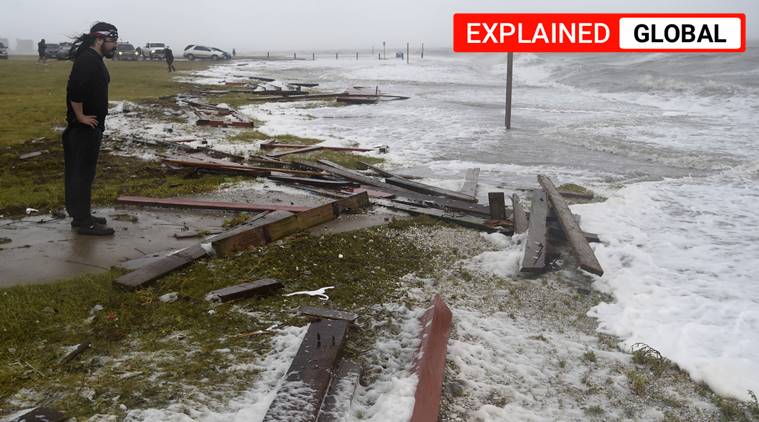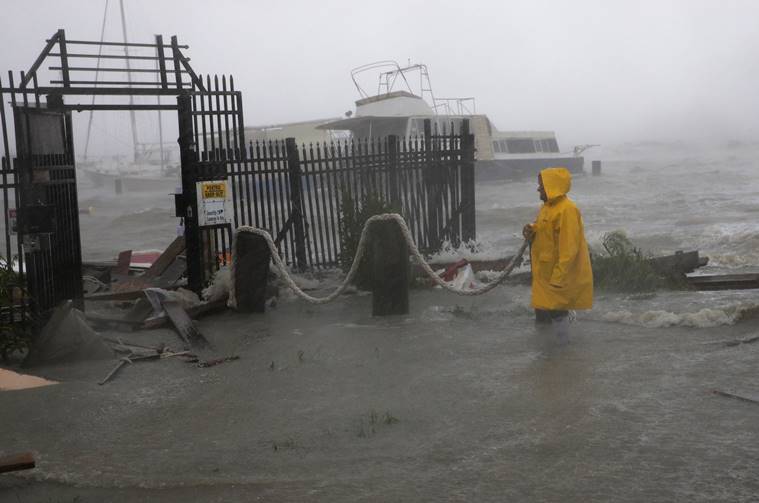 A man stands along the Bayfront during Hurricane Hanna on Saturday, July 25, in Texas. (Photo: AP)
A man stands along the Bayfront during Hurricane Hanna on Saturday, July 25, in Texas. (Photo: AP)
Texas, which is one of the largest hotspots for Covid-19 in the US, is now facing another threat, as Hurricane Hanna made landfall here on Saturday (July 25). Officials have warned about a life-threatening storm surge and strong winds, at a time when Texas has more than 380,000 Covid-19 cases and has recorded over 5,000 deaths.
How intense is Hurricane Hanna?
Hanna reached wind speeds of up to 90 mph. The hurricane is expected to produce heavy rains across portions of southern Texas and northeastern Mexico, which will result in “life-threatening” flash flooding and isolated minor to moderate river flooding.
As per the latest update issued by the National Hurricane Centre (NHC), the centre of Hanna has moved into northeastern Mexico and the storm surge warning for Texas has been discontinued.
Also Read | Explained: How Covid-19 lockdowns caused a drop in seismic noise levels worldwide
There are five categories of tropical cyclones, depending on the wind speeds. Hanna is category one. When winds in the rotating systems reach 39 mph, the storm is called a tropical storm and when they reach 74 mph, the tropical storm can be classified as a tropical cyclone or a hurricane and is also given a name.
Once tropical cyclones make landfall, they become weaker since they are no longer fed by the heat of the ocean, but before dying out completely, they move far inland dumping inches of rainwater and causing wind damage.
In May, the National Oceanic and Atmospheric Administration (NOAA) announced that this year, an “above-normal” hurricane season is expected in the US. One reason for this is the warmer-than-average sea surface temperatures in the tropical Atlantic Ocean and the Caribbean Sea, along with weaker tropical Atlantic trade winds and an enhanced west African monsoon.
What are hurricanes and how do they form?
Tropical cyclones or hurricanes use warm, moist air as fuel and therefore form over warm ocean waters near the equator. As NASA describes it, when the warm, moist air rises upward from the surface of the ocean, it creates an area of low air pressure below. When this happens, the air from the surrounding areas, which has higher pressure, enters this space, eventually rising when it becomes warm and moist too.
As the warm and moist air continues to rise, the surrounding air will keep entering the area of low air pressure. When the warm air rises and cools off, the water in the air forms clouds and this system of clouds and winds continues to grow and spin, fuelled by the ocean’s heat and the water that evaporates from its surface.
Also Read | Why Thailand’s students have demanded amendments to school haircut rules
As such storm systems rotate faster and faster, an eye forms in the centre. Storms that form towards the north of the equator rotate counterclockwise and those that form south of the equator spin clockwise because of the rotation of the Earth on its axis.
How are tropical cyclones named?
Since 1953, Atlantic tropical storms have been named according to lists by the National Hurricane Center (NHC). In 1978, it was decided that the NHC will use alternating men and women’s names, on the lines of the practice adopted by Australia’s bureau of meteorology three years earlier in 1975.
 A man examines the damage at a dock destroyed by Hurricane Hanna in Corpus Christi, Texas. (Photo: AP)
A man examines the damage at a dock destroyed by Hurricane Hanna in Corpus Christi, Texas. (Photo: AP)
These names are maintained and updated by an international committee of the World Meteorological Organisation (WTO). The WTO represents over 120 countries and uses pre-determined lists of names for each ocean basin of the world. Typically, the names should be short and should be readily understood when broadcast.
There are six such lists of names with 21 names each (each starting with one alphabet except Q, U, X, Y and Z because names beginning with these letters are in short supply) that are used in rotation, which is to say that the list of names attributed to Atlantic tropical storms in 2019 will also be used in 2025.
However, names of storms that caused particular damage and deaths are retired and in case there are more storms than names in the list, NHC names them using the Greek alphabet. Some of the retired names include Erika (2015), Irma (2017) and Florence (2018) among several others.
Further, the only time that a storm may be renamed is when it dissipates to a tropical disturbance and reforms.
Why is it important to name tropical cyclones?
Adopting names for tropical storms makes it easier for people to remember, as opposed to numbers and technical terms. Apart from the general public, it also helps the scientific community, the media, disaster managers etc.
With a name, it is easy to identify individual cyclones, create awareness of its development, rapidly disseminate warnings to increased community preparedness and remove confusion where there are multiple cyclonic systems over a region.
📣 Express Explained is now on Telegram. Click here to join our channel (@ieexplained) and stay updated with the latest
“Experience shows that the use of short, distinctive names in written as well as spoken communications is quicker and less subject to error than the older, more cumbersome latitude-longitude identification methods. These advantages are especially important in exchanging detailed storm information between hundreds of widely scattered stations, coastal bases, and ships at sea,” the NOAA website says.
What is the difference between a hurricane and a tropical storm?
There is no difference. Depending on where they occur, hurricanes may be called typhoons or cyclones. As per NASA, the scientific name for all these kinds of storms is tropical cyclones. The tropical cyclones that form over the Atlantic Ocean or the eastern Pacific Ocean are called hurricanes and the ones that form in the Northwest Pacific are called typhoons.
📣 The Indian Express is now on Telegram. Click here to join our channel (@indianexpress) and stay updated with the latest headlines
For all the latest Explained News, download Indian Express App.
© IE Online Media Services Pvt Ltd
"severe" - Google News
July 26, 2020 at 08:59PM
https://ift.tt/3hBbCWs
Hurricane Hanna hits Texas: How hurricanes are formed, how severe is this one - The Indian Express
"severe" - Google News
https://ift.tt/2OrY17E
Shoes Man Tutorial
Pos News Update
Meme Update
Korean Entertainment News
Japan News Update
Bagikan Berita Ini















0 Response to "Hurricane Hanna hits Texas: How hurricanes are formed, how severe is this one - The Indian Express"
Post a Comment